
Grade 5 confederation Readings
- Subject:
- History
- Social Studies
- Material Type:
- Textbook
- Date Added:
- 10/17/2022

Sun West endorsed resources.
Sun West endorsed resources.

Grade 5 confederation Readings

Today we’re going to talk about confidence intervals. Confidence intervals allow us to quantify our uncertainty, by allowing us to define a range of values for our predictions and assigning a likelihood that something falls within that range. And confidence intervals come up a lot like when you get delivery windows for packages, during elections when pollsters cite margin of errors, and we use them instinctively in everyday decisions. But confidence intervals also demonstrate the tradeoff of accuracy for precision - the greater our confidence, usually the less useful our range.

In which John Green teaches you about conflict in Israel and Palestine. This conflict is often cast as a long-term beef going back thousands of years, and rooted in a clash between religions. Well, that's not quite true. What is true is that the conflict is immensely complicated, and just about everyone in the world has an opinion about it. John is going to try to get the facts across in under 13 minutes.

A variety of student activities and teacher resources for using the concept of 'making connections' as a reading strategy.

Ideas for integrating food into the classroom from guest blogger Sarah Anderson.
*Making personal placemats
*Narrative Writing
*Research Paper
*Mapping Foods
*Podcasts

Students in grades 4-6 engage in a series of activities (both inside and outside the classroom) designed to inspire a sense of environmental stewardship. Each of the activities is intended to have children explore their profound connection to nature and experience the power of individual and collective action.
Students explore the daily choices, they, their families, their school and their communities make; the impact of those choices on nature; and the role they and others may take in protecting nature.
The activities are fun, hands-on, and thought provoking. Students have opportunities to share what they are learning with their fellow students, family, and community and to create their own “class foundation” to collectively act on their concerns and passions.
The resource consists of 16 cross-curricular lessons on a range of issues from which teachers may select according to the dictates of their time and curriculum.

Using a "Thirty-Second Look" activity, students will look closely at and describe the painting A Centennial of Independence. The students will read their ideas and note line, shape, and other details. Then students will create a favorite outdoor memory inspired by the painting, using crayons and the elements of art to guide their work. They will also make connections to the theme of "teamwork."
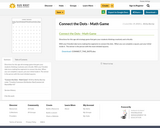
Directions for this age old strategy game that gets your students thinking creatively and critically:
With your friend(s) take turns making line segments to connect the dots. When you can complete a square, put your initial inside it. The winner is the person with the most initialed squares.

Hank wraps up the Crash Course on ecology by taking a look at the growing fields of conservation biology and restoration ecology, which use all the kung fu moves we've learned about in the past eleven weeks and apply them to protecting ecosystems and to cleaning up the messes that we've already made.
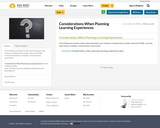
A list of things you should consider when planning for your students, including: learner profiles, elements of PeBL, curricular expectations, strategies, communications, assessments.

This form of painting became popular during the Cultural Revolution in China (1966-1976). Images depicting people's every day lives became a natural focus under the regime of Chairman Mao. Artists in places like Hu County in Shaanxi Province (near Xi'an), where these painting were made, were discovered and became popular. This particular series of Peasant Paintings, by a mature, female artist named Dong, were done in a studio production method.The peasant paintings depict festivals and daily routines: preparing food, doing laundry, traditional parades (lanterns, dragons), animals and fish. Some tell stories with symbolism. This curriculum resource will provide potential lesson topics and areas of discovery and a set of images for teachers of art, Chinese culture & history at elementary, middle and high school levels. The paintings may serve as supplementary visuals for K-8 teachers of science, and geography.

This assignment is based on an integration of current events with an examination of indigenous cultures in North America. There are two final products involved – a presentation and a fullclass discussion.

Students will focus on how one artist tells the story of Joseph using continuous narrative. By observing and discussing visual details such as color and movement found in the painting, students write about what they think is happening. Students are encouraged to use the actions they observed in the painting to create and write a new story with a new character, and then illustrate them in their own continuous narrative.
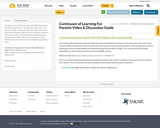
This amazing video will clearly explain the PeBL philosophy at Sun West School Division. The who, what, when, where, why and how of PeBL are addressed and articluated clearly for the parent and community audience. Topics include the continuum of learning, transfer of responsibility, personalized learning, the three pillars of PeBL. This resource will clearly explain everything you need to know to get started embracing PeBL at home!
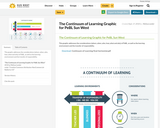
This graphic addresses the considerations (where, when, who, how, what and why) of PeBL, as well as the learning environment and the transfer of responsibility.
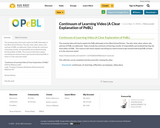
This amazing video will clearly explain the PeBL philosophy at Sun West School Division. The who, what, when, where, why and how of PeBL are addressed. Topics include the continuum of learning, transfer of responsibility, personalized learning, the three pillars of PeBL. This resource will clearly explain everything you need to know to get started embracing PeBL at home or in the classroom today!
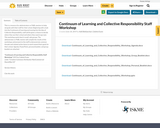
This is a resource for adminstrators or PeBL mentors to help set goals with their staff for their school. Beginning with a look into the Continuum of Learning and moving into the idea of Collective Responsibility, staff will be given a chance to decide where they see their school and where they want to go next. This workshop works best in small, safe groups. The adminstrator or PeBL mentor will compile the results of the workshops and present to the staff to demonstrate common threads and related action items to work toward their goals for their school.
Agenda, PowerPoint, personal booklet, and group booklet are attached.

We may be living IN a simulation (according to Elon Musk and many others), but that doesn't mean we don't need to perform simulations ourselves. Today, we're going to talk about good experimental design and how we can create controlled experiments to minimize bias when collecting data. We'll also talk about single and double blind studies, randomized block design, and how placebos work.

- Student Presentations
- Conversation Practice
- Professional Development
- Rich Assessment
- Safe and Accountable

PHYSICAL SCIENCE, STEM CAREERS
In this video, learn from chemical engineers Laura and Wade about what it takes to become a chemical engineer and why it's a great career. Find out how chemical engineers do things like save the environment, take waste and make it useful, and solve real-world problems every day.
ABOUT THE SCIENCE
What do disposable diapers, soda, hydrogen fuel cells, aluminum, penicillin and snowboards have in common? They were all invented or further processed by a chemical engineer!
Are you someone who likes to solve problems? Do you like making something new? Do you care about the environment? If so, being a chemical engineer might just be for you!
As an engineer in this field, you get to apply chemistry to the industrial process to make things. It takes technology, innovation, and ideas to help generate an end result.
An example of this is through making textiles out of weeds! As a chemical engineer, first you would put the weeds through a processing system, have them pulped, put through an extruder to create a fiber, and then voila! You can use that to create textiles. To ensure chemical engineers are being friendly to the environment, their decision making always considers renewable resources.